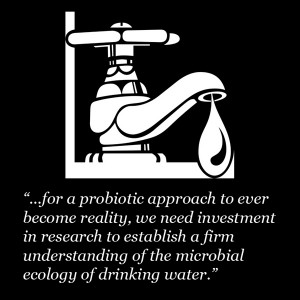Hats off to Tuesday’s New York Times article, “A Quest for Even Safer Drinking Water,” for daring to bring microbiology to the people. The article sheds light several key reasons we can no longer afford to ignore the vast microbial diversity that exists within the drinking water environment, among them are opportunistic pathogens and antibiotic resistance.
Also this week, Hong Wang, Marc Edwards, Joe Falkinham and I are pleased to announce the web release of our “Just Accepted” article in Environmental Science & Technology, “Probiotic Approach to Pathogen Control in Premise Plumbing Systems?”. This review article lays out some of the underlying principles of our current Sloan MoBE project, Effect of Pipe Materials, Water Flow, and Chemistry on the Building Plumbing Microbiome.
As highlighted in the New York Times article, we have our water infrastructure to thank for saving countless lives by virtually eliminating the spread of fecal-borne disease, such as typhoid, and also upholding the excellent standard of living we enjoy today. However, our generation faces a new challenge, as the primary source of waterborne disease in developed countries is no longer fecal in origin. Instead, they are organisms that happily establish within the drinking water pipes and fixtures, calling the dark, low carbon, high disinfectant environment “home”. These include opportunistic pathogens, such as: Legionella pneumophila, Mycobacterium avium complex, Pseudomonas aeruginosa, and Acanthamoeba. This is a game-changer for the water industry, which is geared towards control of fecal pathogens. The challenge of opportunistic pathogens faced by water utilities is highlighted in a recent Water Research Foundation report.
Considering that opportunistic pathogens establish as part of the drinking water microbial ecology, our Environmental Science & Technology article builds the case for the need for a “probiotic” framework for thinking about and developing strategies for opportunistic pathogen control. Unfortunately, past paradigms have allowed us to fool ourselves into thinking that chlorine kills everything in the water- far be it from true! Chlorine simply creates a new environment and in some cases can even select for certain pathogens or other undesirable conditions (e.g., mycobacteria, antibiotic resistance, and corrosion). In our article, we explore what a probiotic approach might look like, broadly inclusive of any action to intentionally manipulate the microbial ecology, either through inoculation of beneficial microbes or selective conditions such as water chemistry, flow, pipe material, and disinfectant (the latter may more precisely be defined as a “pre-biotic”). A probiotic approach may be particularly suited for premise (i.e., building) plumbing, which is more subject to conditions such as stagnation, loss of disinfectant residual, and warmer temperatures (relative to the municipal pipe system), which can all act to further boost microbial numbers and potential for pathogens to establish.
Of course, for a probiotic approach to ever become reality, we need investment in research to establish a firm understanding of the microbial ecology of drinking water. Research is needed to identify key interactions among microbes and with water chemistry and pipe materials that might translate into master variables for controlling waterborne disease. Next-generation DNA sequencing tools are opening a new and powerful window for capturing such relationships. But perhaps even more important is opening the window of our minds to not only accept, but to embrace the reality of microbes in our water. Not all microbes are “bad,” and in fact, most are harmless or even beneficial from a human standpoint. I think the New York Times article is an indicator that today’s citizen is ready to face the truth about microbes in our water, and that is an important first step to improving our water infrastructure and advancing public health.

New at #microBEnet: Probiotics for Plumbing?: Hats off to Tuesday’s New York Times article, “A Quest for Even … http://t.co/iF6I5aTgrm
Amy Pruden writes about “Probiotics for Plumbing?” on the #microbeNet blog: http://t.co/LoQR4iOG6J
“Probiotics for Plumbing?†http://t.co/s4cAXoSAxB /via @phylogenomics #fb
RT @phylogenomics: Amy Pruden writes about “Probiotics for Plumbing?” on the #microbeNet blog: http://t.co/LoQR4iOG6J
RT @phylogenomics: Amy Pruden writes about “Probiotics for Plumbing?” on the #microbeNet blog: http://t.co/LoQR4iOG6J
RT @microBEnet: Probiotics for Plumbing?: #microBEnet http://t.co/Oh9ed39Iqn